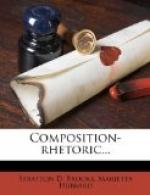2. The first thing to be noted about the dress of the Romans is that its prevalent material was always woolen. Sheep raising for wool was practiced among them on an extensive scale, from the earliest historic times, and the choice breeds of that animal, originally imported from Greece or Asia Minor, took so kindly to the soil and climate of Italy that home-grown wool came even to be preferred to the foreign for fineness and softness of quality. Foreign wools were, however, always imported more or less, partly because the supply of native wools seems never to have been quite sufficient, partly because the natural colors of wools from different parts varied so considerably as to render the art of the dyer to some extent unnecessary. Thus, the wools of Canusium were brown or reddish, those of Pollentia in Liguria were black, those from the Spanish Baetica, which comprised Andalusia and a part of Granada, had either a golden brown or a grayish hue; the wools of Asia were almost red; and there was a Grecian fleece, called the crow colored, of which the natural tint was a peculiarly deep and brilliant black.
—Preston and Dodge: ’The Private Life of the Romans.
3. Art has done everything for Munich. It lies on a large flat plain sixteen hundred feet above the sea and continually exposed to the cold winds from the Alps. At the beginning of the present century it was but a third-rate city, and was rarely visited by foreigners; since that time its population and limits have been doubled, and magnificent edifices in every style of architecture erected, rendering it scarcely secondary in this respect to any capital in Europe. Every art that wealth or taste could devise seems to have been spent in its decoration. Broad, spacious streets and squares have been laid out; churches, halls, and colleges erected, and schools of painting and sculpture established which drew artists from all parts of the world.
—Taylor: Views Afoot.
4. In all excursions to the woods or to the shore the student of ornithology has an advantage over his companions. He has one more, avenue of delight. He, indeed, kills two birds with one stone and sometimes three. If others wander, he can never get out of his way. His game is everywhere. The cawing of a crow makes him feel at home, while a new note or a new song drowns all care. Audubon, on the desolate coast of Labrador, is happier than any king ever was; and on shipboard is nearly cured of his seasickness when a new gull appears in sight.
—Burroughs: Wake Robin.
+Theme XXVIII.+—Write a paragraph, using any method or combination of methods which best suits your thought. Use any of the subjects hitherto suggested that you have not already used.
(Is every sentence related to the topic statement so that your paragraph possesses unity? What methods of development have you used?)




